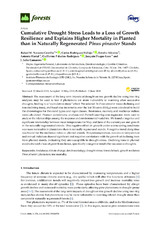Mostrar el registro sencillo del ítem
Cumulative Drought Stress Leads to a Loss of Growth Resilience and Explains Higher Mortality in Planted than in Naturally Regenerated Pinus pinaster Stands
| dc.contributor.author | Navarro Cerrillo, Rafael M. | |
| dc.contributor.author | Rodríguez, Carlos | |
| dc.contributor.author | Silveiro, Emidio | |
| dc.contributor.author | Hortal, Antonio | |
| dc.contributor.author | Palacios Rodríguez, Guillermo | |
| dc.contributor.author | Duque Lazo, Joaquín | |
| dc.contributor.author | Camarero, J. Julio | |
| dc.date.accessioned | 2018-10-02T08:29:24Z | |
| dc.date.available | 2018-10-02T08:29:24Z | |
| dc.date.issued | 2018 | |
| dc.identifier.uri | http://hdl.handle.net/10396/17209 | |
| dc.description.abstract | The assessment of the long-term impacts of drought on tree growth decline using tree-ring analyses may be used to test if plantations are more vulnerable to warming after successive droughts, leading to a “cumulative stress” effect. We selected 76 Pinus pinaster trees (declining and non-declining trees), and basal area increments over the last 20 years (BAI20) were calculated to build the chronologies for the stand types and vigor classes. Resistance, recovery and resilience indices were calculated. Pearson correlations, analyses and Partial Least-Squares regression were used to analyze the relationships among the response and environmental variables. We found a negative and significant relationship between mean temperature for May and June of the current year and growth in the naturally regenerated stands. This negative effect on growth under warm spring conditions was more noticeable in plantations than in naturally regenerated stands. A negative trend along time was found for the resilience index in planted stands. Evapotranspiration, maximum temperature and annual radiation showed significant and negative correlations with the growth of declining trees from planted stands, indicating they are susceptible to drought stress. Declining trees in planted stands showed a loss of growth resilience, specifically a negative trend after successive droughts. | es_ES |
| dc.format.mimetype | application/pdf | es_ES |
| dc.language.iso | eng | es_ES |
| dc.publisher | MDPI | es_ES |
| dc.rights | https://creativecommons.org/licenses/by/4.0/ | es_ES |
| dc.source | Forests 9, 358 (2018) | es_ES |
| dc.subject | Andalusia | es_ES |
| dc.subject | Climate change | es_ES |
| dc.subject | Dendroecolology | es_ES |
| dc.subject | Drought stress | es_ES |
| dc.subject | Forest dieback | es_ES |
| dc.subject | Growth resilience | es_ES |
| dc.subject | Pinus pinaster | es_ES |
| dc.subject | Plantation | es_ES |
| dc.subject | Tree mortality | es_ES |
| dc.title | Cumulative Drought Stress Leads to a Loss of Growth Resilience and Explains Higher Mortality in Planted than in Naturally Regenerated Pinus pinaster Stands | es_ES |
| dc.type | info:eu-repo/semantics/article | es_ES |
| dc.relation.publisherversion | http://dx.doi.org/10.3390/f9060358 | es_ES |
| dc.relation.projectID | Gobierno de España. RTA2014-00005-00-00 | es_ES |
| dc.relation.projectID | Gobierno de España. CGL2017-86161-R (ESPECTRAMED) | es_ES |
| dc.rights.accessRights | info:eu-repo/semantics/openAccess | es_ES |

